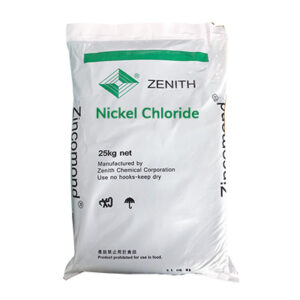Product name: Nickel sulfate hexahydrate
Other names: Nickel sulfate
Chemical formula: NiSO4.6H2O
Content 98%
Origin: Germany, Japan, Korea, Taiwan
Specification: 25kg/bag
Nickel sulfate or nickel sulfate, nickel sulfate has the chemical formula NiSO4.6H2O. It is a blue, toxic, odorless crystal and is widely used in industries in general and electroplating chemicals in particular. In which, they are mainly used in iron plating technology, pharmaceuticals, inorganic chemistry, dyeing technology…
Origin of nickel sulfate
They occur as the rare mineral retgersite, which is the hexahydrate form.
The second known hexahydrate form is nickel hexahydride (Ni,Mg,Fe)SO4·6H2O, in this form it is relatively unstable in air, and occurs as the mineral morenosite. The monohydrate form is known as the very rare mineral dwornikite (Ni,Fe)SO4·H2O.
Characteristics of nickel sulfate
Nickel sulfate exists as green or blue crystals.
Molecular mass: 262.85 g/mol.
Density: 2.07g/cm3.
They are soluble in water and ethanol.
Compounds of nickel sulfate
– Compounds with NH3 such as: NiSO4·½NH3 is a yellow-green solid, NiSO4·2NH3 is a light green crystal, 2NiSO4·5NH3·7H2O is a light purple crystal, NiSO4·3NH3 is a light purple powder, NiSO4·4NH3·2H2O is a dark blue solid, NiSO4·5NH3·H2O is a blue crystal, NiSO4·6NH3 is a light purple solid.
– Compounds with N2H4 such as: 4NiSO4·3N2H4·7H2O are green crystals, NiSO4·N2H4·3H2O is a blue solid, NiSO4·2N2H4·2H2O is a blue-green crystal, NiSO4·3N2H4 is a lavender crystal.
– Compounds with NH2OH such as: NiSO4·6NH2OH are red crystals.
– Compounds with CO(NH2)2 such as: NiSO4·2CO(NH2)2·4H2O are pale green crystals. NiSO4·6CO(NH2)2·H2O also has similar properties.
– Compounds with CON3H5 such as: NiSO4·2CON3H5 are light green-bright positive crystals, NiSO4·2CON3H5 are dark positive crystals.
– Compounds with CS(NH2)2 such as: NiSO4·2CS(NH2)2 appear in two forms: red-brown and gray-green.
Nickel sulfate can form acidic salts with N2H4 such as: Ni(HSO4)2·2N2H4 is an apple green crystal, slightly soluble in water.
Is nickel sulfate toxic?
In 2005–2006, nickel sulfate was the leading allergen in skin patch tests (19%).
The chemical is now classified as a human carcinogen, a finding observed in epidemiological studies of sulfide ore refinery workers.
Applications of nickel sulfate in life and production
– They are by-products of copper smelting, produced by the dissolution of nickel metal or nickel oxide in sulfuric acid.
– Apply them to make electrolytic solution in nickel plating tank to help create color and color of dyes,…
– Widely used in electroplating, organic synthesis, non-ferrous metals as well as in making other color dyes.
– This chemical is also used in the production of Nickel salt, Ni-Cd batteries, etc.
– Aqueous solution of nickel sulfate reacts with sodium carbonate to form a precipitate of nickel carbonate, which is the precursor of nickel-based catalysts and pigments.
– Used a lot in the laboratory.
Notes on safe use and storage of nickel sulfate
Notes on safe storage of nickel sulfate
Nickel sulfate placed in the workplace must be stored carefully to avoid polluting the environment and affecting people around.
Store this chemical in a cool, dry place away from direct sunlight.
Chemical warehouses must be separated to avoid chemical leakage or spillage causing pollution.
Chemical warehouses must be located far from residential areas, away from water sources, places that store water for daily life or farming because it will seriously affect health.
What should be noted when using nickel sulfate?
When exposed to nickel sulfate chemicals in particular and other chemicals in general, it is necessary to equip yourself with appropriate tools and full protective equipment.




Reviews
There are no reviews yet.